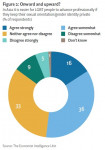Midsize manufacturers remain bullish on growth despite a tougher demand environment, according to new research from the Economist Intelligence Unit
It is all the more surprising, then, that they retain a surprisingly strong appetite for growth. Well over half (61%) of executives of medium-size producers surveyed by the Economist Intelligence Unit·and three-quarters of those from Asia-Pacific·expect to register annual revenue growth of 15% or more over the next three years. Nearly as many (55%) see similar growth in profits.
These are among the conclusions of a new study, Growth and complexity: The challenges ahead for midsize manufacturers, written by the Economist Intelligence Unit and sponsored by SAP. It is the first in a series of six papers to be published in the coming months on critical issues faced by midsize producers.
Other key findings of the research including the following:
· Midsize manufacturers will seek to grow primarily through better and faster product development. Expanding the product mix is important to many manufacturers, but enhancing their ability to customise existing products in numerous variations is also becoming an imperative. Just as critical amid intense competition is accelerating time to market of new products. Manufacturers’ ability to improve product development is thus closely intertwined with their ability to boost operating efficiency and improve their management of customer demand.
· Improving operating efficiency is viewed as integral to enable future growth. The majority of respondents (56%) view better operating efficiency, rather than revenue growth, as the key to meeting profit targets. To boost efficiency, manufacturers will prioritise the implementation of "demand-driven manufacturing"·which entails building products in response to customer orders rather than to inventory·as well as "lean manufacturing" and other improvement programmes.
· Midsize producers expect the advantages of agility, flexibility and customer intimacy that many hold over larger firms to erode as they expand in size. In particular, almost 40% of survey respondents are concerned that continued growth will impact negatively on their agility·the ability to change strategic course quickly. Many are also concerned that greater scale will reduce their operational flexibility and the ability to maintain strong customer relationships.
· IT is central to manufacturers' ability to retain these attributes. Midsize producers have arguably been slower than firms in other sectors to deploy IT systems across all enterprise functions, but this is changing. Updating obsolete systems will be the main driver of new IT spending, but boosting efficiency, increasing management visibility into operations and improving customer service are also key IT investment drivers.
"In order to cope with the cost and demand pressures and meet their growth targets, manufacturers must take great pains to boost their operating efficiency," says Denis McCauley, Director of Global Technology Research at the Economist Intelligence Unit. "Greater efficiency is also imperative to become more responsive to changes in customer demand," he adds.
Growth and complexity: The challenges ahead for midsize manufacturers can be found on the Economist Intelligence Unit's new online home for manufacturing research and analysis: The manufacturing centre of excellence http://sponsor.sap.manufacturingcentre.eiu.com
Notes for editors
About the survey
The research for this report, and the five others to be published in this series, is based on an online survey, conducted in November 2007, of 179 senior executives of midsize manufacturing firms·defined here as producers having annual revenue of between US$20m and US$500m. Our respondents came from across the globe, with 46% being C-level executives such as CEOs, CFOs and CIOs, as well as owners. They represent over 20 discrete and process manufacturing industries. To obtain additional insight, we also conducted a series of in-depth interviews with senior executives of midsize producers.
About the Economist Intelligence Unit
The Economist Intelligence Unit is the world leader in global business intelligence. It is the business-to-business arm of The Economist Group, which publishes The Economist newspaper. The Economist Intelligence Unit provides geopolitical, economic and business analysis on more than 200 countries, as well as strategic intelligence on key industries and management practices. With over 300 full-time professionals in 40 offices around the world, supported by a global network of more than 700 contributing analysts, the Economist Intelligence Unit is widely known for its unparalleled coverage of major and emerging markets. More information about the Economist Intelligence Unit can be found at www.eiu.com.
웹사이트: http://www.eiu.com
연락처
Edgar Fernandez
Marketing Manager, Asia-Pacific
(852) 2585 3826 이메일 보내기
Fax: (852) 2802 7007
이 보도자료는 Economist Intelligence Unit가(이) 작성해 뉴스와이어 서비스를 통해 배포한 뉴스입니다.




